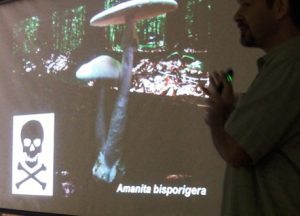
Early Europeans believed the sudden, seemingly overnight appearance of mushroom and toadstool proved fairies and malicious spirits had been in the area. Mushroom are the reproductive structure of fungi. Mushroom spores aide in dispersal and species survival. Some fungi form hard, permanent conk, while other mushrooms may be soft and temporary.

Fungi play an important role in recycling organic matter. By design, mycelium’s fine thread-like network lack chlorophyll and are not able to produce their own food. They secrete enzymes and digest food outside of their bodies, obtaining nourishment from decomposing animals, leaf litter and organic material. Click to view Dr. Matthew Smith, Associate Professor, UF Department of Plant Pathology providing brief overview of fascinating fungi.
Specific hardwood, pine or palm species may have associated fungi.

Because look-alike species and poisonous mushroom grow in Florida, misidentification is possible. If eaten, the result could be Illness or death. Dr. Matthew Smith, Associate Professor, UF Department of Plant Pathology cautions against consumption of unidentified Florida mushroom.
Avid gardeners may enjoy growing edible mushrooms. UF’s Solutions for Your Life provides tips for Shitake and oyster mushroom production. In addition, Common Florida Mushrooms, by Dr. James W. Kimbrough, is available from UF’s Institute of Food and Agricultural Sciences (IFAS) bookstore. It’s an interesting read while snacking on store bought, battered and fried mushrooms (ranch dressing on the side, please). Until next time – Happy Gardening!
 0
0
